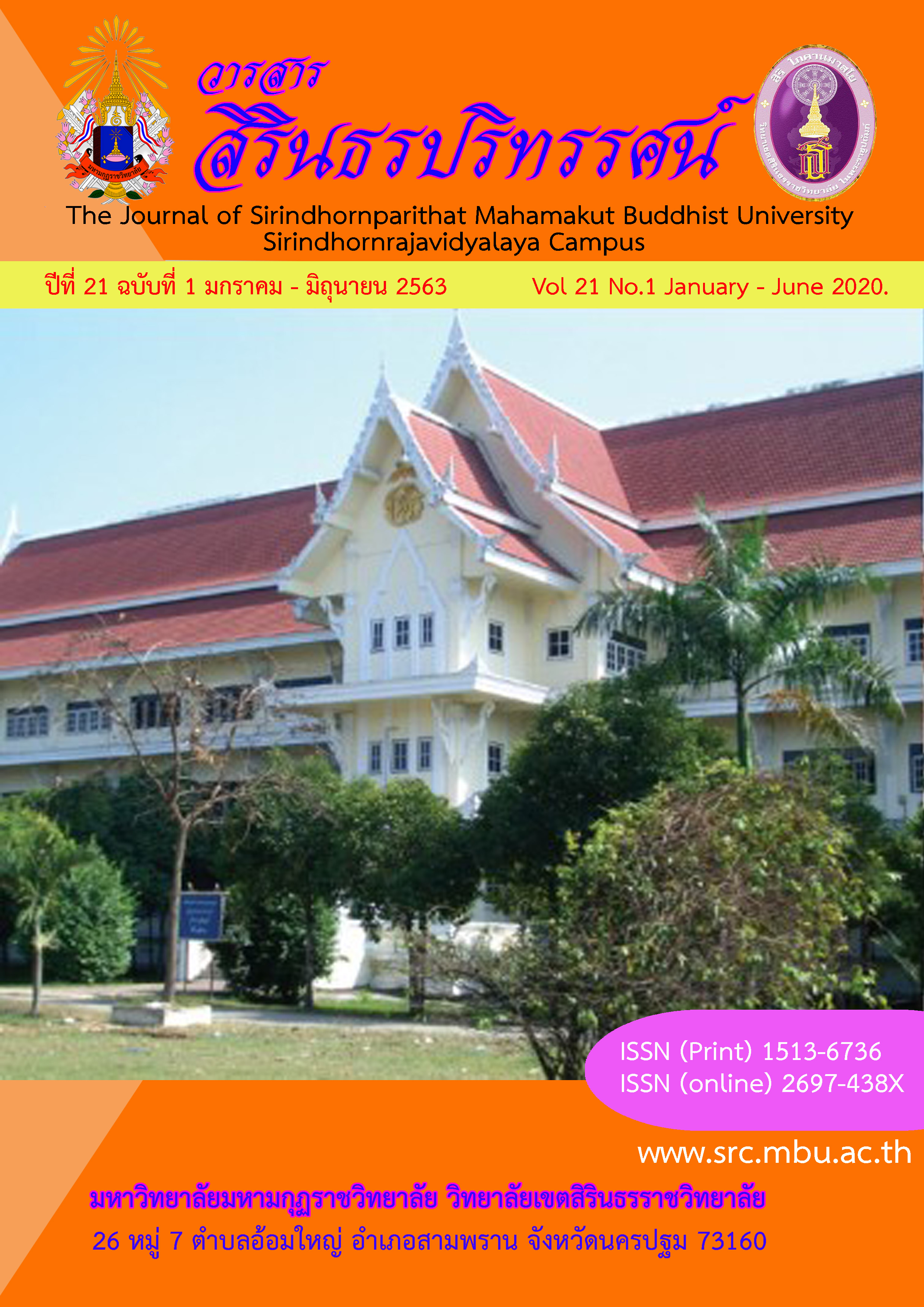The Lesson Summary of Applying the “Toyota Technique of Summarizing Everything into a One Page Paper” in the Class “History of Buddhism” Taught to Students of Mahamakut Buddhist University, Siridthonrajavidyalaya Campus
Keywords:
Lesson Summary, Content Analysis, ImpartationAbstract
The research is a Quasi-Experimental Design. The purposes of this research were 1) to study the lesson summary of applying the “Toyota technique of summarizing everything into a one page paper” in the class “History of Buddhism” taught to students of Mahamakut Buddhist University, Siridhonrajavidyalaya Campus and 2) to compare the lesson summary of applying the “Toyota technique of summarizing everything into a one page paper” in the class “History of Buddhism” taught to students thereof. The class was comprised of 12 freshmen of regular session, enrolled in the Religion and Philosophy Faculty, Program in Buddhist Studies and Social Sciences Faculty, Program in government, during the first semester of B.E. 2562 (2019) academic year. The research samples were selected by means of purposeful sampling. The research instruments were comprised of pretest and posttest of the lesson summary of applying the “Toyota technique of summarizing everything into a one page paper” in the class “History of Buddhism” taught to students thereof and its assessment form by using Rubric criteria to evaluate its content. The statistics used to computerize the data were frequency, percentage, mean, standard deviation and t-test.
The findings were found as follows:
- 1. In overall of the 3 aspects test, the pretest score of the result of lesson summary was at fair level (
 = 1.69), while its posttest score, was at good level (
= 1.69), while its posttest score, was at good level ( =3.25).
=3.25). - In overall of the 3 aspects test, the result of comparative score of the posttest was higher than the pretest at the statistically significant level of 0.01.
References
นิออน ประสูติทวี. (2556). ผลการจัดกิจกรรมการเรียนรู้โดยใช้แผนที่ความคิดต่อผลสัมฤทธิ์ทางการเรียนวิทยาศาสตร์และความสามารถในการสรุปบทเรียนของนักเรียนชั้นมัธยมศึกษาปีที่ 2 โรงเรียนขยายโอกาสเขตเทศบาลสุไหงโก-ลก. วิทยานิพนธ์ครุศาสตรมหาบัณฑิต สาขาวิชาหลักสูตรและการสอน บัณฑิตวิทยาลัย มหาวิทยาลัยราชภัฏจันทเกษม.
บรรจง แสงนภาวรรณ. (2556). การพัฒนาทักษะการอ่านคิดวิเคราะห์ของนักเรียนชั้นประถมศึกษาปีที่ 6 . วิทยานิพนธ์ศึกษาศาสตรมหาบัณฑิต สาขาวิชาหลักสูตรและการนิเทศ. บัณฑิตวิทยาลัย มหาวิทยาลัยศิลปากร.
บุญทิพย์ ศิริธรังศรี. (2554). หลักการและเทคนิคการเขียนตำรา. วารสารวิจัยทางวิทยาศาสตร์สุขภาพ. 5(2) : 1-7.
บุษรา ดาโอะ. (2549). ผลของการสรุปบทเรียนโดยใช้ผังกราฟิกที่มีต่อผลสัมฤทธิ์ทางการเรียนกลุ่มสาระการเรียนรู้วิทยาศาสตร์ของนักเรียนชั้นประถมศึกษาปีที่ 4 ที่มีผลสัมฤทธิ์ทางการเรียนต่ำกว่าเกณฑ์. วิทยานิพนธ์ศึกษาศาสตรมหาบัณฑิต สาขาวิชาการประถมศึกษา มหาวิทยาลัยสงขลานครินทร์.
ปรีชาญ เดชศรี และเกตุวดี กัมพลาศิริ. (2552). การศึกษาแนวโน้มผลสัมฤทธิ์ทางการเรียนคณิตศาสตร์นานาชาติ. กรุงเทพฯ: สถาบันส่งเสริมการสอนวิทยาศาสตร์และดทคโนโลยี (สสวท.).
มูลนิธิดรุณาทร. (2561). สถานการณ์เยาวชนไทย. [ออนไลน์] สืบค้นเมื่อ 31 ตุลาคม 2561. จาก
http://www.compassionth.com/?page_id=6260
ราชกิจจานุเบกษา. (2562). พระราชบัญญัติการศึกษาแห่งชาติ พ.ศ. 2542 แก้ไขเพิ่มเติม (ฉบับที่ 2) พ.ศ. 2545 และ (ฉบับที่ 3) พ.ศ. 2553. [ออนไลน์] สืบค้นเมื่อ 31 ตุลาคม 2561. จาก https://person.mwit.ac.th/01-Statutes/NationalEducation.pdf
วัชรา เล่าเรียนดี. (2552). รูปแบบและกลยุทธ์การจัดการเรียนรู้เพื่อพัฒนาทักษะการคิด. พิมพ์ครั้งที่ 4. กรุงเทพฯ: มหาวิทยาลัยศิลปากร.
สุนทรี วัฒนพันธุ์. (2556). การพัฒนารูปแบบการสอนวิทยาศาสตร์ที่ส่งเสริมการคิดวิเคราะห์ของนักเรียนระดับชั้นมัธยมศึกษา. วิทยานิพนธ์ครุศาสตร์มหาบัณฑิต สาขาวิชาหลักสูตรและการสอน. มหาวิทยาลัยราชภัฏวไลยอลงกรณ์ ในพระบรมราชูปถัมภ์ จังหวัดปทุมธานี.
สุวธิดา ล้านสา. (2558). การพัฒนาชุดกิจกรรมการเรียนรู้ โดยใช้กระบวนการสืบเสาะหาความรู้เพื่อส่งเสริมความสามารถในการคิดวิเคราะห์และจิตวิทยาศาสตร์สาหรับนักเรียนชั้นประถมศึกษาปีที่ 4. วิทยา นิพนธ์ศึกษาศาสตรมหาบัณฑิต สาขาวิชาหลักสูตรและการนิเทศ บัณฑิตวิทยาลัย มหาวิทยาลัยศิลปากร.
อธิปัตย์ คลี่สุนทร. (2559). แบบจำลองการสอนแบบจุลภาคเรื่องการสรุปบทเรียน. วิทยานิพนธ์ครุศาสตรมหาบัณฑิต สาขาวิชาโสตทัศนศึกษา จุฬาลงกรณมหาวิทยาลัย.
อะชะดะ ซุงุรุ. (2558). เทคนิคสรุปทุกอย่างลงในกระดาษแผ่นเดียวที่ฉันเรียนรู้มาจากโตโยต้า. (ภาณุพันธ์ ปัญญาใจ, ผู้แปล) กรุงเทพฯ: วีเลิร์น.
เอกภูมิ ชูนิตย์. (2553). การพัฒนาบทเรียนคอมพิวเตอร์ช่วยสอน เรื่องทวีปเอเชีย ที่สรุปบทเรียนด้วยแผนที่ความคิดสำหรับนักเรียนชั้นมัธยมศึกษาชั้นปีที่ 2. นครปฐม: มหาวิทยาลัยศิลปากร.
ฮัสหน๊ะ บือราเห็ง. (2550). ผลของการสรุปบทเรียนโดยใช้ผังกราฟิกที่มีต่อความคิดเชิงสาเหตุและผลสัมฤทธิ์ทางการเรียนวิชาสังคมศึกษาของนักเรียนชั้นมัธยมศึกษาปีที่ 2. วิทยานิพนธ์ ศึกษาศาสตรมหาบัณฑิต สาขาวิชาจิตวิทยาการศึกษา มหาวิทยาลัยสงขลานครินทร์.
Stemler, S. (2000). An overview of content analysis. Practical Assessment, Research, and Evaluation, 7(1) : 1-6. [Online]. Retrieved February 20, 2020, from
Downloads
Published
Issue
Section
License
บทความที่ได้รับการตีพิมพ์เป็นลิขสิทธิ์ของ มหาวิทยาลัยมหามกุฏราชวิทยาลัย วิทยาเขตสิรินธรราชวิทยาลัย
ข้อความที่ปรากฏในบทความแต่ละเรื่องในวารสารวิชาการเล่มนี้เป็นความคิดเห็นส่วนตัวของผู้เขียนแต่ละท่านไม่เกี่ยวข้องกับหาวิทยาลัยมหามกุฏราชวิทยาลัย วิทยาเขตสิรินธรราชวิทยาลัย และคณาจารย์ท่านอื่นๆในมหาวิทยาลัยฯ แต่อย่างใด ความรับผิดชอบองค์ประกอบทั้งหมดของบทความแต่ละเรื่องเป็นของผู้เขียนแต่ละท่าน หากมีความผิดพลาดใดๆ ผู้เขียนแต่ละท่านจะรับผิดชอบบทความของตนเองแต่ผู้เดียว




